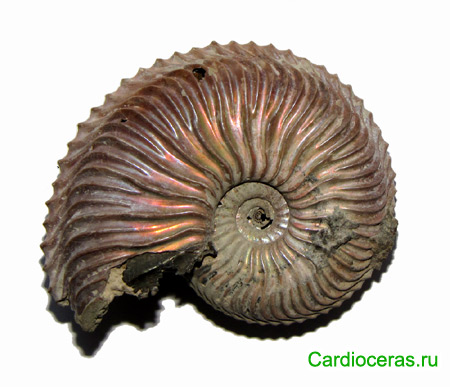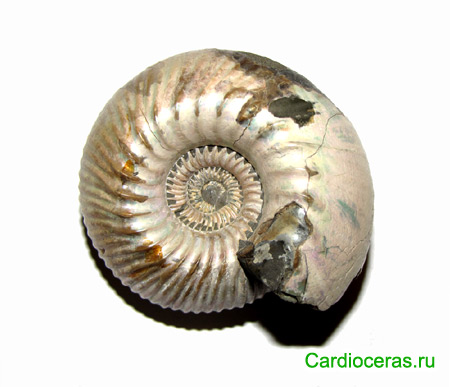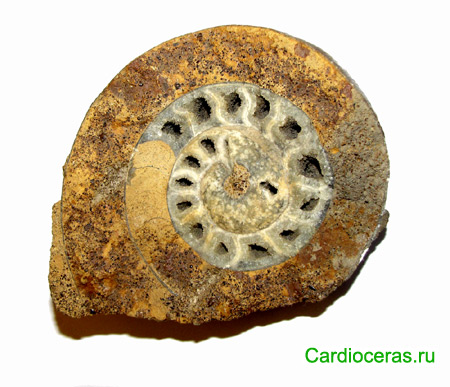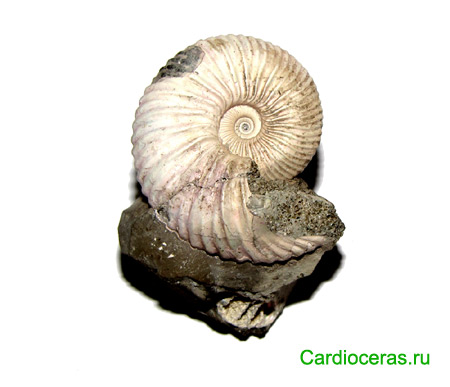Cardioceratidae
Cardioceratidae - the ammonite family, which occupied almost the entire boreal region of the Northern Hemisphere in the late Middle Jurassic and early Late Jurassic. Their shells are found in Siberia, Eastern and Western Europe and in North America. Representatives of Cardioceratidae widely known from Russia, Poland, the UK, France and Canada. Cardioceratids largely determined the appearance of the ammonite fauna of Central Russia over the centuries during the Jurassic period. These were the boreal ammonites - the polar sea was their homeland.
Cardioceratidae appeared at the Bajocian-Bathonian border (~168 mya) of the Middle Jurassic and became extinct in the late Kimmeridgian age of the Late Jurassic (~152 mya). They have existed for more than 10 million years, for four geological ages (Bathonian, Callovian, Oxfordian and Kimmeridgian)and survived many other families of ammonites.
Paleontologists distinguish four subfamilies in the Cardioceratidae family: Arctocephalitinae, Cadoceratinae, Quenstedtoceratinae and Cardioceratinae. Ammonites from the Sphaeroceratidae family were ancestors of the Cardioceratids. Cardioceratidae branched off from them somewhere in Siberia or Alaska in the Late Bajocian. Some researchers believe that the first Cardioceratidae genus was Cranocephalites (J. Callomon), others contend that it was more ancient genus Boreiocephalites (Meledina).
Cardioceratidae - a family with typical sexual dimorphism for ammonites, have large females (macroconchs) and very small males (microconchs). Cardioceratids were middle-sized ammonites, the giants were not among them. Macroconchs' diameter did not exceed 20 centimeters, therefore, they were not larger than modern Nautilus. Microconchs shells were even smaller: from 1.5-2 up to 10-12 cm in different species.
However, the type of Cardioceratidae dimorphism is markedly different from dimorphism of other ammonite families. Their microconchs had no lateral apertural extentions on the terminal aperture. All Cardiotseratid neighbors, which lived in the seas of Callovian, Oxfordian and Kimmeridgian ages had lappets. All other ammonite families: southern Oppeliidae, spike-wearing Kosmoceratidae, very numerous and evolutionarily successful Perisphinctidae, had microconchs with lappets. But not Cardiotseratidae microconchs. Cardioceratidae apertures were decorated by rostrums: a ventral projection. Both sexes had a rostrum, but as a rule, macroconchs (females) had more rounded and shorter rostrums than microconchs (males).
However, despite the lack of lappets, problems with the definition of the sex in Cardioceratidae did not arise - their microconchs are always much smaller, and often thinner than macroconchs. In many species these differences exist in the early whorls.
Discrete-sized groups were observed between Cardioceratidae microconchs and macroconchs. it is not surprising that Matjia described his "miniconchs" (small microconchs) based on study Quenstedtoceras genus.
It is also interesting that among sexual antidimorphs in Cardioceratid species there was great variability in the length of living chambers. For example, the length of Pseudocadoceras microconchs living chamber is a half whorl, while in corresponding macroconchs Rondiceras or Funiferites, exceeds a whole whorl.

Cardioceras sp. Microconch, Cardioceratinae subfamily. Upper Jurassic, Lower Oxfordian. |

Ammonite Cadoceras elatmae. Macroconch, Cadoceratinae subfamily. Lower Callovian, Middle Jurassic. |

Ammonite Rondiceras sp. The living chamber occupied more than one whorl. This is macroconch from Cadoceratinae subfamily. Lower Callovian, Middle Jurassic. |

Ammonite Novocadoceras sp. Microconch with well-preserved apperture and ventral projection (rostrum). Cadoceratinae subfamily. Lower Callovian, Middle Jurassic. |

